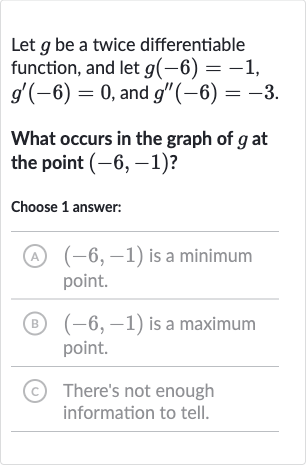Full solution
Q. Let be a twice differentiable function, and let , , and .What occurs in the graph of at the point ?Choose answer:(A) is a minimum point.(B) is a maximum point.(C) There's not enough information to tell.
- Analyze Given Information: First, we analyze the given information about the function at the point . We are given that , which means the point lies on the graph of .
- Consider First Derivative: Next, we consider the first derivative . This indicates that the slope of the tangent to the graph of at is zero, which means the graph has a horizontal tangent line at this point. This could be indicative of a local maximum, local minimum, or a saddle point (inflection point).
- Look at Second Derivative: We then look at the second derivative . Since the second derivative is negative, it tells us that the graph of is concave down at . This concavity, combined with the horizontal tangent line, means that the point is a local maximum.
- Conclude Maximum Point: Given the information about the first and second derivatives at , we can conclude that is a maximum point on the graph of .

